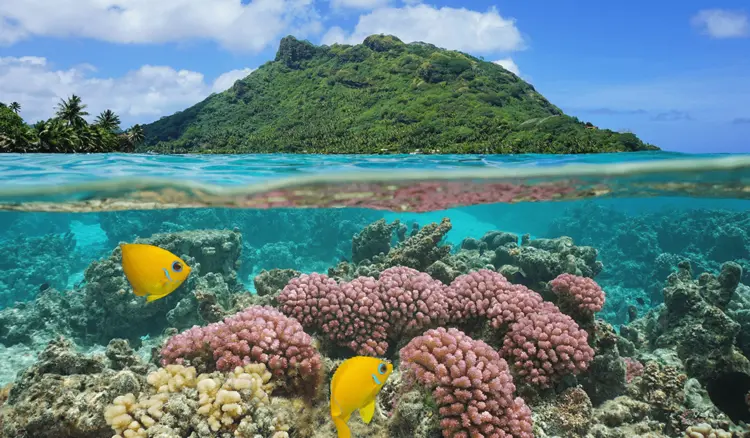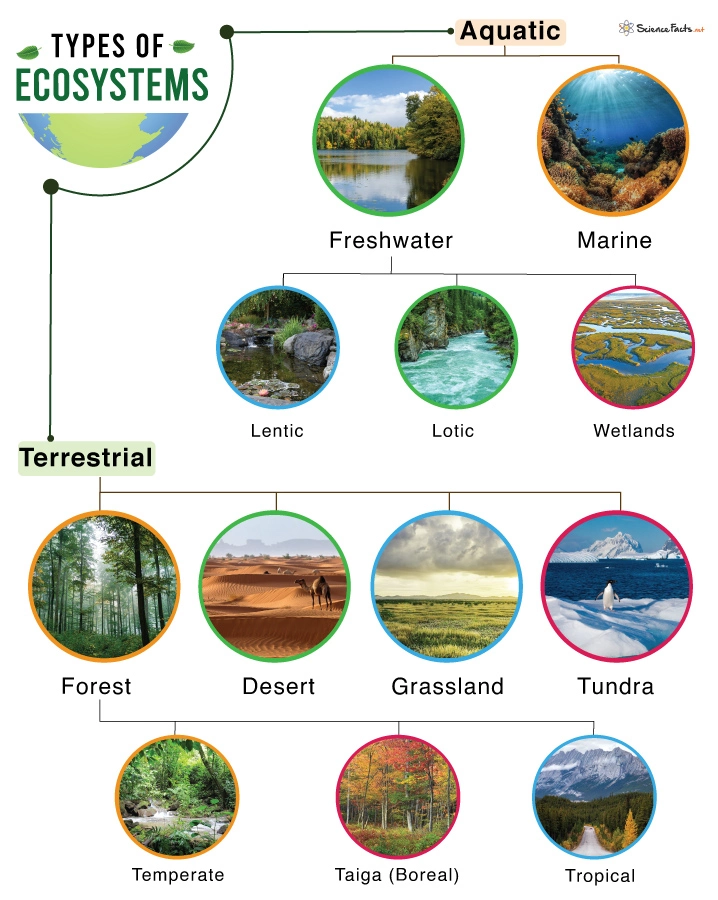Natural Ecosystems
Definitions, Types, Examples, and Benefits

What Is An Ecosystem?
An ecosystem represents the fundamental unit of an environment, comprising both living (biotic) and non-living (abiotic) components that interact continuously. These ecosystems can be broadly categorized into two types:
Natural ecosystems: These occur spontaneously in nature.
Artificial ecosystems: These are intentionally created by humans.
In an ecosystem, plants, animals, weather, and the landscape collaborate to create a dynamic “bubble of life.” Biotic factors include living organisms like plants and animals, while abiotic factors encompass nonliving elements such as rocks, temperature, and humidity.
Every component within an ecosystem is interconnected, either directly or indirectly. For instance, changes in temperature can significantly impact the types of plants that thrive there. Animals relying on specific plants for sustenance and shelter must adapt, relocate, or face extinction.
Ecosystems vary greatly in size. Even tiny ecosystems, like tide pools formed when ocean tides recede, exhibit intricate interactions. In a tide pool, seaweed (algae) undergoes photosynthesis to produce food, which herbivores like abalone consume. Carnivores, such as sea stars, feed on other animals like clams and mussels. These tide pools depend on the ebb and flow of ocean water. Some organisms thrive underwater during high tides, while others, like hermit crabs, rely on shallow pools during low tides.
Earth’s entire surface comprises interconnected ecosystems. These ecosystems often form part of larger biomes in extensive regions of land, sea, or atmosphere. Examples of biomes include forests, ponds, reefs, and tundra. Each biome hosts a diverse array of ecosystems, shaped by the specific plants and animals that inhabit them.
What Are Natural Ecosystems?
Natural ecosystems represent a harmonious community of living and non-living entities, existing freely in nature. Through physical, chemical, and biological processes, every component collaborates as a cohesive unit. The defining feature of natural ecosystems lies in their complete independence from human influence, unlike artificial ecosystems. Soil, sunlight, air, water, plants, animals, and microorganisms drive these interactions within natural ecosystems, either directly or indirectly. For instance, fluctuations in temperature directly impact plant growth.
Natural ecosystems are self-sustaining and operate without human intervention. They emerge from the intricate interplay between living organisms and their surroundings. Examples include lakes, forests, oceans, and deserts. These expansive, interconnected communities foster balance among plants, animals, and the environment.
Throughout this article, we’ll delve into natural ecosystems, exploring their components, examples, types, and the distinctions between natural and artificial ecosystems.
Examples of Natural Ecosystems
A few examples of Natural Ecosystems are:
Forest Ecosystems: Forests, covering 31% of Earth’s land, harbor dense canopies of trees teeming with diverse bird species and insects. Notable examples include the Amazon Rainforest and the Boreal Forest.
Aquatic Ecosystems: Encompassing both marine and freshwater habitats, aquatic ecosystems feature coral reefs and a rich array of marine animals. Water, covering 75% of Earth’s surface, plays a pivotal role.
Desert Ecosystems: Despite their seemingly barren appearance, deserts host resilient flora and fauna adapted to harsh conditions. The Sahara Desert and the Sonoran Desert serve as prime examples. These ecosystems can be either hot or cold, resulting in sparse vegetation and fewer animal inhabitants .
How Do Natural Ecosystems Work?
Natural ecosystems operate as ‘balanced’ systems, where interactions among various organisms contribute to stability. For instance, in grassland ecosystems, herbivores consume grass but also enrich the soil with their droppings, allowing grass to regenerate and maintain equilibrium. However, healthy ecosystems are not static; they continually evolve due to dynamic processes.
Biocenosis living organisms interacting with their environment play a crucial role. Animals compact soil, plants regulate humidity and temperature, and bacteria protect animals from diseases and aid digestion. Additionally, external events, such as climatic phenomena, trigger environmental transformations. Consequently, living organisms within an ecosystem adapt to these constraints, driving change.
Interestingly, despite their pursuit of stability, ecosystems never achieve perfect balance. Natural imbalances persistently offset one another. Some ecosystems evolve slowly, while others transform rapidly. In extreme cases, ecosystems may even vanish.
Types Of Natural Ecosystems

The size of every ecosystem varies. On earth, ecosystems are interlinked to make biomes – land or atmosphere, the area of sea, forests, reefs etc. Depending upon the habitats, biomes are connected with each other which possess several ecosystems. There are two main types of natural ecosystems:
Terrestrial ecosystem: Land-based
Aquatic ecosystem: Water-based
There are various other types of ecosystems. Listed below are the types of ecosystems which are categorized into either terrestrial or aquatic ecosystems
Desert Ecosystem
The desert ecosystem can be seen existing in the arctic as well as the tropics. As presumed, not all of the deserts are hot. Some are usually windy. The most striking feature of this ecosystem is the amount of precipitation it receives, which is the least as compared to any other ecosystem. A few deserts consist of rocks while some have sand dunes. Flora is very rare, but highly adaptive animal species and insects are found here.
Forest Ecosystem
The forest ecosystem is classified on the basis of the climate which can either be tropical, temperate or boreal. In temperate zones, the forest ecosystem can have a deciduous, coniferous type or a combination of both types of flora. The tropics have rainforest ecosystems which include the most diverse animal and plant ecosystem in comparison to any region on the planet. In this region, trees are found growing tall, with denser foliage and humid environment wherein species are found right from the roots up till the canopy.
Marine Ecosystem
The marine ecosystem refers to the aquatic ecosystem containing saltwater and harbors a range of species. This ecosystem is the vastest and the biggest ecosystem on earth. They not only embed the oceanic beds, but also the salt marshes, tidal zones, saltwater swamps, mangroves, coral reefs etc.
Freshwater Ecosystems
The freshwater ecosystem refers to the aquatic ecosystem containing consumable water, as opposed to marine ecosystems, they are concerned with the ecosystem found in the lakes, ponds, rivers, springs, freshwater swamps that have fresh water. They nurture planktons, algae, insects, amphibians and underwater plants.
Tundra Ecosystem
Tundra symbolizes polar regions at relatively lower altitudes. It is identified by harsh environmental conditions correlated to deserts and is habitually treeless, windswept and snow-covered. The soil is found frozen all through the year and throughout the fleeting summers, snow melts to produce shallow ponds, thereby giving rise to lichens and small flowers.
Grassland Ecosystem
The grassland ecosystems are found in steppes, savannas, and prairies, in the tropical and temperate regions. They can be found in colder regions and have a prevalent feature: semi-aridity. The trees in these regions are close to non-existence and flowers may be distributed along with the grass. These ecosystems are typical for animal-grazing.
Natural Ecosystems Services: Examples
Without ecosystem services, life on Earth as we know it wouldn’t exist. There are four main categories of ecosystem services:
Provisioning services refer to the products secured by ecosystems. These include:
• Water
• Food (including cattle and seafood)
• Pharmaceuticals, biochemicals, and industrial products
• Energy (sunlight, hydropower, biomass)
Regulating services are the ecosystem services that allow the regulation of ecosystem processes such as:
• Climate regulation (and carbon absorption and storage via the oceans, trees, soil)
• Waste decomposition (one of the most essential microbial process happening in soil)
• Crop pollination (performed by agents such as bees that contribute to the reproduction of flowering plants)
• Water and air purification and regulation
• Control of pests and diseases
Supporting and habitat services refer to the ability of ecosystems to give habitat for migratory species and to support the viability of gene-pools.This is possible thanks to:
• Primary reproduction
• Nutrient and seed dispersal
Cultural services are the benefits ecosystem services bring to humans. Examples of these are:
• Inspiration for intellectual (creativity), cultural (entertainment) and spiritual (why) purposes
– Remember how it feels good to seeing and hearing wild birds
– Animals, plants and even the fungi kingdom serve as inspiration in theaters, movies…
– Many people go to natural sites when they want to be alone or reflect about life
• Recreational experiences such as outdoors activities or ecotourism
• Scientific discovery and optimization/efficiency by following examples of the natural world (biomimicry)
Conclusion
In conclusion, natural ecosystems are the interaction of living and non-living elements of our planet. Understanding the diversity of ecosystems is crucial for the health of the Earth. The ecosystem is important for the continuity of life. Natural ecosystems can survive without the help of humans and thus are known as self-sustaining. Interruptions from humans in natural ecosystems can cause disruptions in the whole process.
FAQs
Q.What are Natural Ecosystems?
Natural ecosystems result from interactions between organisms and their environment. They are self-sustaining and do not require human intervention. Examples include deserts, oceans, lakes, and forests.
Q.Can you provide an example of a Natural Ecosystem?
Certainly! Natural ecosystems encompass mountains, rivers, forests, grasslands, and more. Additionally, ecosystems can be either human-made or artificial.
Q.What defines the geography of a Natural Ecosystem?
A natural ecosystem is a geographical area inhabited by plants, animals, and other organisms. It also includes the surrounding landscape and weather conditions.
Q.What components make up Natural Ecosystems?
Natural ecosystems consist of both living and nonliving elements. These components interact with each other to maintain ecosystem balance.
Q.How do Natural Ecosystems differ from Artificial Ecosystems?
1.Natural Ecosystems: These are self-sustaining environments where organisms interact with each other and their surroundings.
2.Artificial Ecosystems: Human-created environments where living and nonliving components interact.
Q.What drives changes in Natural Ecosystems?
Natural changes occur through various processes, including weather-related shifts, plant and animal succession, and geological transformations.
Q.Why are biodiversity and ecosystem health interconnected?
Biodiversity the variety of life forms directly impacts ecosystem health. Diverse ecosystems are more resilient, better able to adapt to environmental changes, and provide essential services to humans.
Q.How can we conserve and restore Natural Ecosystems?
Conservation efforts involve protecting habitats, reducing pollution, and promoting sustainable practices. Restoration includes reforestation, wetland rehabilitation, and reintroducing native species.